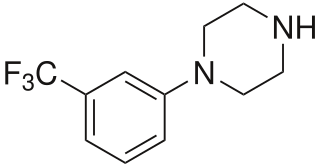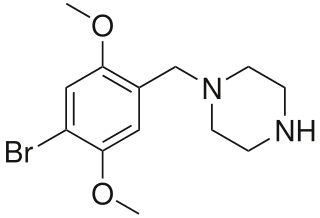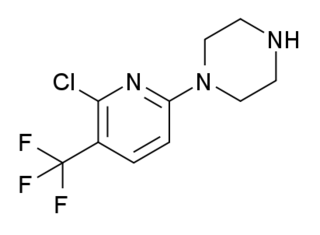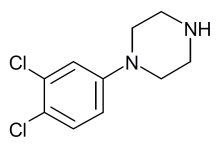
Benzylpiperazine (BZP) is a recreational drug with euphoriant and stimulant properties. The effects produced by BZP are comparable to those produced by amphetamine. Adverse effects have been reported following its use including acute psychosis, renal toxicity and seizures. Deaths from piperazine derivatives are extremely rare, but there has been at least one death apparently due to BZP alone. Its sale is banned in several countries, including Australia, Canada, New Zealand, the United States, the Republic of Ireland, the United Kingdom, Bulgaria, Romania and other parts of Europe.

3-Trifluoromethylphenylpiperazine (TFMPP) is a recreational drug of the phenylpiperazine chemical class and is a substituted piperazine. Usually in combination with benzylpiperazine (BZP) and other analogues, it is sold as an alternative to the illicit drug MDMA ("Ecstasy").

Piperazine is an organic compound that consists of a six-membered ring containing two nitrogen atoms at opposite positions in the ring. Piperazine exists as small alkaline deliquescent crystals with a saline taste.

Party pills, also known as "herbal highs", "pep pills" "dance pills" and "natural power", is a colloquialism for a type of recreational drug whose main ingredient was originally benzylpiperazine (BZP), but has expanded to a wide range of compounds with a variety of effects. BZP is banned in a few countries, including the USA, Republic of Ireland, Australia and New Zealand, but is available on a more or less restricted basis in many jurisdictions. A range of other piperazine derivatives have also been sold as ingredients in party pills, and many of these branded "proprietary blends" have subsequently been sold in countries around the world.

meta-Chlorophenylpiperazine (mCPP) is a psychoactive drug of the phenylpiperazine class. It was initially developed in the late-1970s and used in scientific research before being sold as a designer drug in the mid-2000s. It has been detected in pills touted as legal alternatives to illicit stimulants in New Zealand and pills sold as "ecstasy" in Europe and the United States.

para-Methoxyphenylpiperazine is a piperazine derivative with stimulant effects which has been sold as an ingredient in "Party pills", initially in New Zealand and subsequently in other countries around the world.

para-Fluorophenylpiperazine is a piperazine derivative with mildly psychedelic and euphoriant effects. It has been sold as an ingredient in legal recreational drugs known as "Party pills", initially in New Zealand and subsequently in other countries around the world.

Antrafenine (Stakane) is a phenylpiperazine derivative drug invented in 1979. It acts as an analgesic and anti-inflammatory drug with similar efficacy to naproxen, but is not widely used as it has largely been replaced by newer drugs.

Piberaline is a psychoactive drug and member of the piperazine chemical class which was developed in the 1980s. It has stimulant and antidepressant effects which are thought to be due largely to its active metabolite benzylpiperazine. It was researched to a limited extent in Hungary and Spain, but was not widely accepted and does not seem to be in current use, although a closely related drug befuraline with similar effects has been slightly more successful.

Methylbenzylpiperazine is a stimulant drug which is a derivative of benzylpiperazine. MBZP has been sold as an ingredient in legal recreational drugs known as "party pills", initially in New Zealand and subsequently in other countries around the world.

4-Bromo-2,5-dimethoxy-1-benzylpiperazine (2C-B-BZP) is a psychoactive drug and research chemical of the piperazine chemical class which has been sold as a "designer drug". It produces stimulant effects similar to those of benzylpiperazine (BZP).

1-(3,4-Methylenedioxybenzyl)piperazine is a chemical compound of the piperazine chemical class related to benzylpiperazine (BZP). MDBZP has been sold as a designer drug and has even been found as an ingredient in street Ecstasy pills.

1-(2-Pyrimidinyl)piperazine (1-PP, 1-PmP) is a chemical compound and piperazine derivative. It is known to act as an antagonist of the α2-adrenergic receptor (Ki = 7.3–40 nM) and, to a much lesser extent, as a partial agonist of the 5-HT1A receptor (Ki = 414 nM; Emax = 54%). It has negligible affinity for the dopamine D2, D3, and D4 receptors (Ki > 10,000 nM) and does not appear to have significant affinity for the α1-adrenergic receptors. Its crystal structure has been determined.

2,3-Dichlorophenylpiperazine (2,3-DCPP or DCPP) is a chemical compound from the phenylpiperazine family. It is both a precursor in the synthesis of aripiprazole and one of its metabolites. It is unclear whether 2,3-DCPP is pharmacologically active as a serotonin receptor agonist similar to its close analogue 3-chlorophenylpiperazine (mCPP), though it has been shown to act as a partial agonist of the dopamine D2 and D3 receptors.

ORG-12962 is a pyridinylpiperazine drug developed by Organon, which acts as a potent and selective agonist for the 5-HT2 receptor family, with highest affinity at 5-HT2C and lowest at 5-HT2B subtypes. It was developed as a potential anti-anxiety drug, but was discontinued from human trials after tests in a public speaking challenge showed that its anti-anxiety effects were accompanied by side effects such as dizziness and a "spacey" feeling, which were attributed to poor selectivity in vivo over the hallucinogenic 5-HT2A receptor.

1-[4-(Trifluoromethyl)phenyl]piperazine (pTFMPP) is a serotonergic releasing agent. It is rarely encountered as a designer drug but is much less common than the "normal" isomer meta-TFMPP.

1-(3-Chlorophenyl)-4-(2-phenylethyl)piperazine (3C-PEP) is a designer drug of the piperazine class of chemical substances. 3C-PEP is related to meta-cholorophenylpiperazine (mCPP) and phenethylamine that can be thought of as mCPP having a phenylethyl group attached to the nitrogen atom at its 4-position. It was first described in 1994 in a patent disclosing a series of piperazine compounds as sigma receptor ligands. Later, it was discovered to be a highly potent dopamine reuptake inhibitor.

ortho-Methylphenylpiperazine (also known as oMPP, oMePP, 1-(2-methylphenyl)piperazine, 2-MPP, and 2-MePP) is a psychoactive designer drug of the phenylpiperazine group. It acts as a serotonin–norepinephrine–dopamine releasing agent (SNDRA), with EC50 values for induction of monoamine release of 175 nM for serotonin, 39.1 nM for norepinephrine, and 296–542 nM for dopamine. As such, it has about 4.5-fold preference for induction of norepinephrine release over serotonin, and about 7.6- to 13.9-fold preference for induction of norepinephrine release over dopamine.

3-Methylbenzylpiperazine (3-Me-BZP) is a stimulant drug which is a derivative of benzylpiperazine. It has been sold as a designer drug, first being identified in Sweden in February 2012.































